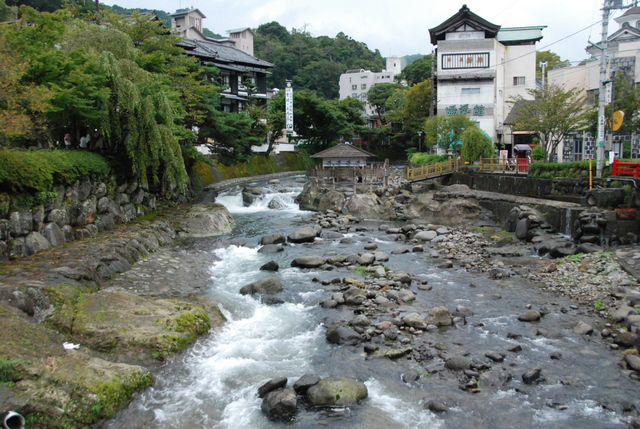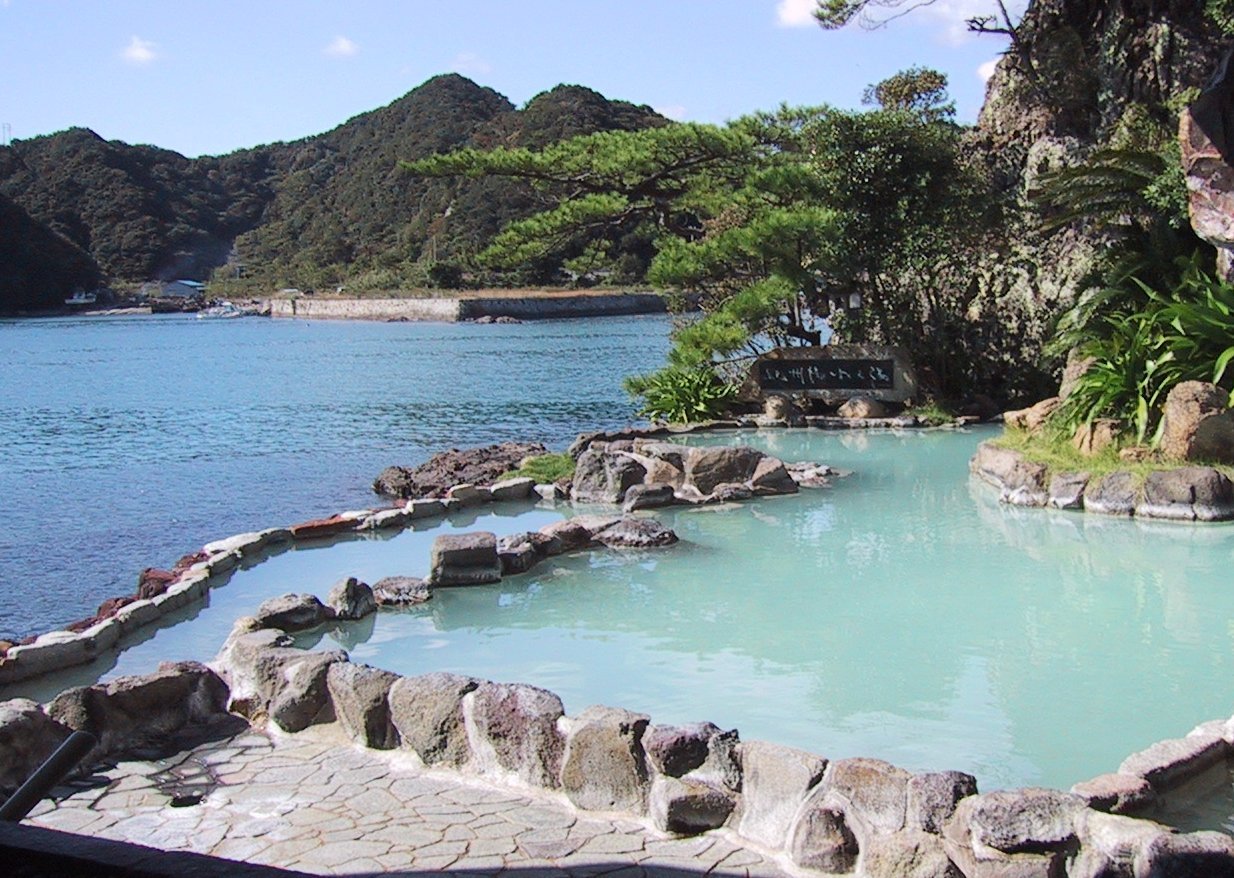|
Shuzenji
was a town located in Tagata District, Shizuoka Prefecture, Japan, in central Izu Peninsula. As of March 1, 2004, final population data before the amalgamation, the town had an estimated population of 16,328 and a density of 236.5 persons per km². The total area was 69.04 km². On April 1, 2004 Shuzenji, along with the towns of Amagiyugashima, Nakaizu and Toi (all from Tagata District), was merged to create the city of Izu. Shuzenji was located in an inland region of Izu Peninsula and was noted for its numerous onsen hot spring resorts. The area was also noted for its production of ''wasabi'' and ''shiitake The shiitake (alternate form shitake) (; ''Lentinula edodes'') is an edible mushroom native to East Asia, which is now cultivated and consumed around the globe. It is considered a medicinal mushroom in some forms of traditional medicine. T ...''. The town of Shuzenji was founded on April 1, 1889 within Kimisawa District, Shizuoka. In 1896, Kimisawa Dis ... [...More Info...] [...Related Items...] OR: [Wikipedia] [Google] [Baidu] |
Izu, Shizuoka
is a city located in central Izu Peninsula in Shizuoka Prefecture, Japan. , the city had an estimated population of 30,678 in 13,390 households, and a population density of 84 persons per km2. The total area of the city was . Geography Izu is located in the north-central portion of the Izu Peninsula, and includes most of the Amagi Mountains. The region is hilly and some 80% of the city area is covered by forest. The Kano River runs through the city, which has a short coastline to the west on Suruga Bay of the Pacific Ocean. The area is part of the Izu-Tobu volcanic region, and is therefore subject to frequent earthquakes, and the city also has numerous hot springs as a result. Warmed by the Kuroshio Current, the area enjoys a warm maritime climate with hot, humid summers and mild, cool winters. Surrounding municipalities *Shizuoka Prefecture ** Numazu ** Izunokuni ** Itō **Higashiizu ** Kawazu **Nishiizu Demographics Per Japanese census data, the population of Izu has ... [...More Info...] [...Related Items...] OR: [Wikipedia] [Google] [Baidu] |
Tagata District, Shizuoka
is a rural district located in Shizuoka Prefecture, Japan. As of July 2012, the district has an estimated population of 38,332 and a population density of . The total area is . The district's administrative centre is the city hall at Mishima City. Towns and villages Tagata District currently is composed of one town. The city of Atami and parts of the cities of Mishima, Izunokuni and Itō were formerly part of the district. *Kannami History Tagata District was one of the original districts of Izu Province, having been separated from Suruga Province in the cadastral reform of 680 AD, and covered most of central Izu Peninsula. Modern Tagata District was established in the July 22, 1878 cadastral reforms initiated by the Meiji government with one town ( Nirayama) and 61 villages. In a round of consolidation on April 1, 1889, this was reduced to seven villages, with Nirayama reduced to village status. However, on April 4, 1896, the area of the district was greatly expanded by po ... [...More Info...] [...Related Items...] OR: [Wikipedia] [Google] [Baidu] |
Shizuoka Prefecture
is a prefecture of Japan located in the Chūbu region of Honshu. Shizuoka Prefecture has a population of 3,637,998 and has a geographic area of . Shizuoka Prefecture borders Kanagawa Prefecture to the east, Yamanashi Prefecture to the northeast, Nagano Prefecture to the north, and Aichi Prefecture to the west. Shizuoka is the capital and Hamamatsu is the largest city in Shizuoka Prefecture, with other major cities including Fuji, Numazu, and Iwata. Shizuoka Prefecture is located on Japan's Pacific Ocean coast and features Suruga Bay formed by the Izu Peninsula, and Lake Hamana which is considered to be one of Japan's largest lakes. Mount Fuji, the tallest volcano in Japan and cultural icon of the country, is partially located in Shizuoka Prefecture on the border with Yamanashi Prefecture. Shizuoka Prefecture has a significant motoring heritage as the founding location of Honda, Suzuki, and Yamaha, and is home to the Fuji International Speedway. History S ... [...More Info...] [...Related Items...] OR: [Wikipedia] [Google] [Baidu] |
Izu Peninsula
The is a large mountainous peninsula with a deeply indented coastline to the west of Tokyo on the Pacific coast of the island of Honshu, Japan. Formerly known as Izu Province, Izu peninsula is now a part of Shizuoka Prefecture. The peninsula has an area of and its estimated population in 2005 was 473,942 people. The peninsula’s populated areas are located primarily on the north and east. Geology Tectonically, the Izu peninsula results from the Philippine Sea Plate colliding with the Okhotsk Plate at the Nankai Trough. The Philippine Sea Plate, the Amurian Plate, and the Okhotsk Plate meet at Mount Fuji, a triple junction. The peninsula itself lies on the Philippine Sea Plate. The southern portion of the peninsula is composed largely of breccia, and the central and northern portions consist of numerous highly eroded volcanoes. The Amagi Mountain Range dominates the center of the peninsula with Mount Amagi () and Mount Atami () in the east and Mount Daruma () in ... [...More Info...] [...Related Items...] OR: [Wikipedia] [Google] [Baidu] |
Toi, Shizuoka
was a town located in Tagata District, Shizuoka Prefecture, Japan on the west coast of Izu Peninsula facing Suruga Bay. As of March 1, 2004, final population data before the amalgamation, the town had an estimated population of 5,203 and a density of 105 persons per km². On April 1, 2004, Toi, along with the towns of Amagiyugashima, Nakaizu and Shuzenji (all from Tagata District), was merged to create the city of Izu. Toi was also home to the Toi gold mine, the second most productive gold mine in Japan after Sado, Niigata is a city located on in Niigata Prefecture, Japan. Since 2004, the city has comprised the entire island, although not all of its total area is urbanized. Sado is the sixth largest island of Japan in area following the four main islands and Ok .... The total area was 49.41 km². It was the location of the world's largest flower clock. External links Izu official website Dissolved municipalities of Shizuoka Prefecture Izu, Shizuoka ... [...More Info...] [...Related Items...] OR: [Wikipedia] [Google] [Baidu] |
Nakaizu, Shizuoka
was a town located in Tagata District, Shizuoka Prefecture, Japan, in central Izu Peninsula. As of March 1, 2004, final population data before the amalgamation, the town had an estimated population of 8,457 and a density of 77.03 persons per km2. The total area was 110.02 km2. On April 1, 2004, Nakaizu, along with the towns of Amagiyugashima, Shuzenji and Toi (all from Tagata District), was merged to create the city of Izu. Nakaizu, located in the Izu-Kogen highlands of central Izu Peninsula was noted for its production of ''wasabi'' and ''shiitake The shiitake (alternate form shitake) (; ''Lentinula edodes'') is an edible mushroom native to East Asia, which is now cultivated and consumed around the globe. It is considered a medicinal mushroom in some forms of traditional medicine. T ...''. External linksIzu City official website(Japanese) Dissolved municipalities of Shizuoka Prefecture Izu, Shizuoka {{Shizuoka-geo-stub ... [...More Info...] [...Related Items...] OR: [Wikipedia] [Google] [Baidu] |
Amagiyugashima, Shizuoka
was a town located in Tagata District, Shizuoka Prefecture, Japan. As of March 1, 2004, final population data before the amalgamation, the town had an estimated population of 7,677 and a density of 56.8 persons per km2. The total area was 135.14 km2. On April 1, 2004, Amagiyugashima, along with the towns of Nakaizu, Shuzenji and Toi (all from Tagata District), was merged to create the city of Izu. Amagiyugashima was noted for its production of ''wasabi''. It was also the location of the Amagi Tunnel, a tourist attraction based on a famous scene in Yasunari Kawabata was a Japanese novelist and short story writer whose spare, lyrical, subtly shaded prose works won him the Nobel Prize in Literature in 1968, the first Japanese author to receive the award. His works have enjoyed broad international appeal a ...'s novel ''The Dancing Girl of Izu''. External linksIzu City official website(Japanese) Dissolved municipalities of Shizuoka Prefecture Izu, Shizuoka [...More Info...] [...Related Items...] OR: [Wikipedia] [Google] [Baidu] |
Onsen
In Japan, are the country's hot springs and the bathing facilities and traditional inns around them. As a volcanically active country, Japan has many onsens scattered throughout all of its major islands. There are approximately 25,000 hot spring sources throughout Japan that provide hot mineral water to about 3,000 genuine onsen establishments. Onsens come in many types and shapes, including and . Baths may be either publicly run by a municipality or privately, often as part of a hotel, ''ryokan'', or . The presence of an onsen is often indicated on signs and maps by the symbol ♨ or the kanji (''yu'', meaning "hot water"). Sometimes the simpler hiragana character ゆ (''yu''), understandable to younger children, is used. Traditionally, onsens were located outdoors, although many inns have now built indoor bathing facilities as well. Nowadays, as most households have their own bath, the number of traditional public baths has decreased, but the number of sightseeing ho ... [...More Info...] [...Related Items...] OR: [Wikipedia] [Google] [Baidu] |
Shiitake
The shiitake (alternate form shitake) (; ''Lentinula edodes'') is an edible mushroom native to East Asia, which is now cultivated and consumed around the globe. It is considered a medicinal mushroom in some forms of traditional medicine. Taxonomy and naming The fungus was first described scientifically as ''Agaricus edodes'' by Miles Joseph Berkeley in 1877. It was placed in the genus '' Lentinula'' by David Pegler in 1976. The fungus has acquired an extensive synonymy in its taxonomic history: *''Agaricus edodes'' Berk. (1878) *''Armillaria edodes'' (Berk.) Sacc. (1887) *''Mastoleucomychelloes edodes'' (Berk.) Kuntze (1891) *''Cortinellus edodes'' (Berk.) S.Ito & S.Imai (1938) *''Lentinus edodes'' (Berk.) Singer (1941) *''Collybia shiitake'' J.Schröt. (1886) *''Lepiota shiitake'' (J.Schröt.) Nobuj. Tanaka (1889) *''Cortinellus shiitake'' (J.Schröt.) Henn. (1899) *''Tricholoma shiitake'' (J.Schröt.) Lloyd (1918) *''Lentinus shiitake'' (J.Schröt.) Singer (1936) *''Le ... [...More Info...] [...Related Items...] OR: [Wikipedia] [Google] [Baidu] |
Wasabi
Wasabi ( Japanese: , , or , ; ''Eutrema japonicum'' or ''Wasabia japonica'') or Japanese horseradish is a plant of the family Brassicaceae, which also includes horseradish and mustard in other genera. The plant is native to Japan and the Russian Far East including Sakhalin, also the Korean Peninsula. It grows naturally along stream beds in mountain river valleys in Japan. It is grown for its rhizomes which are ground into a paste as a pungent condiment for ''sushi'' and other foods. It is similar in taste to hot mustard or horseradish rather than chili peppers in that it stimulates the nose more than the tongue, but freshly grated wasabi has a subtly distinct flavour. However, most common wasabi flavorings are ersatz, and are made of horseradish and food coloring. The two main cultivars in the marketplace are ''E. japonicum'' 'Daruma' and 'Mazuma', but there are many others. The oldest record of wasabi as a food dates to the 8th century AD. The popularity of wasabi in En ... [...More Info...] [...Related Items...] OR: [Wikipedia] [Google] [Baidu] |
Population Density
Population density (in agriculture: Stock (other), standing stock or plant density) is a measurement of population per unit land area. It is mostly applied to humans, but sometimes to other living organisms too. It is a key geographical term.Matt RosenberPopulation Density Geography.about.com. March 2, 2011. Retrieved on December 10, 2011. In simple terms, population density refers to the number of people living in an area per square kilometre, or other unit of land area. Biological population densities Population density is population divided by total land area, sometimes including seas and oceans, as appropriate. Low densities may cause an extinction vortex and further reduce fertility. This is called the Allee effect after the scientist who identified it. Examples of the causes of reduced fertility in low population densities are * Increased problems with locating sexual mates * Increased inbreeding Human densities Population density is the number of people pe ... [...More Info...] [...Related Items...] OR: [Wikipedia] [Google] [Baidu] |
Japan
Japan ( ja, 日本, or , and formally , ''Nihonkoku'') is an island country in East Asia. It is situated in the northwest Pacific Ocean, and is bordered on the west by the Sea of Japan, while extending from the Sea of Okhotsk in the north toward the East China Sea, Philippine Sea, and Taiwan in the south. Japan is a part of the Ring of Fire, and spans an archipelago of 6852 islands covering ; the five main islands are Hokkaido, Honshu (the "mainland"), Shikoku, Kyushu, and Okinawa. Tokyo is the nation's capital and largest city, followed by Yokohama, Osaka, Nagoya, Sapporo, Fukuoka, Kobe, and Kyoto. Japan is the eleventh most populous country in the world, as well as one of the most densely populated and urbanized. About three-fourths of the country's terrain is mountainous, concentrating its population of 123.2 million on narrow coastal plains. Japan is divided into 47 administrative prefectures and eight traditional regions. The Greater Tokyo Ar ... [...More Info...] [...Related Items...] OR: [Wikipedia] [Google] [Baidu] |




